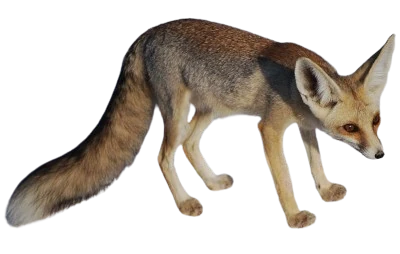
The Rüppell's Fox (Vulpes rueppellii) is a desert-dwelling canid known for its exceptional adaptation to the harsh conditions of the Saharan and Middle Eastern regions.
Rüppell's Fox is small in size, with beige or sandy fur that provides excellent camouflage. It measures between 40 and 52 cm (16–20 inches) in length, excluding its bushy tail, which measures 25 to 39 cm (10–15 inches). It weighs 1.5 to 3 kg (3.3–6.6 pounds). Its large ears help dissipate heat and detect distant sounds.
Rüppell's Fox belongs to the Canidae family. Its scientific classification is as follows:
This fox is perfectly adapted to life in extreme environments.
Rüppell's Fox is found in the arid regions of North Africa, the Middle East, and parts of Central Asia. It prefers sandy or rocky deserts but can also inhabit semi-arid areas.
Primarily nocturnal, Rüppell's Fox avoids extreme temperatures by being active at night. It is mostly solitary but can cooperate with a partner during the breeding season. It marks its territory with scent secretions.
Rüppell's Fox is an omnivorous and opportunistic feeder. Its diet includes small mammals, insects, reptiles, fruits, and seeds. It can survive long periods without drinking water by extracting moisture from its food.
Although Rüppell's Fox is listed as "Least Concern" by the IUCN, it faces increasing threats, including habitat destruction, human-wildlife conflicts, and diseases from domestic animals.
Rüppell's Fox belongs to the Vulpes genus, which also includes the Red Fox (Vulpes vulpes) and the Fennec Fox (Vulpes zerda).
To observe Rüppell's Fox in its natural habitat, follow these tips:
These precautions will ensure a respectful and rewarding observation experience.